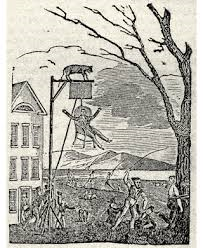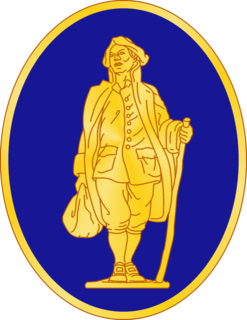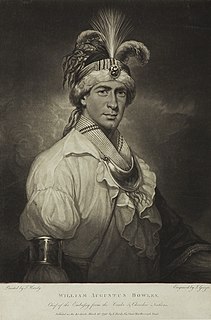 W
WColonists who supported the British cause in the American Revolution were Loyalists, often called Tories, or, occasionally, Royalists or King's Men. George Washington's winning side in the war called themselves "Patriots", and in this article Americans on the revolutionary side are called Patriots. For a detailed analysis of the psychology and social origins of the Loyalists, see Loyalist.
 W
WThis is a list of British units which took part in the American Revolutionary War (1775–1783), fighting against the American rebels and their French, Spanish and Dutch allies in the thirteen North American colonies, including battles in Florida and the West Indies. In addition to the regular army the list includes German auxiliary units, and militia and provincial units formed from Loyalists, West Indians, and Canadians.
 W
WThe 84th Regiment of Foot was a British regiment in the American Revolutionary War that was raised to defend present day Ontario, Quebec and Atlantic Canada from the constant land and sea attacks by American Revolutionaries. The 84th Regiment was also involved in offensive action in the Thirteen Colonies; including North Carolina, South Carolina, Georgia, Virginia and what is now Maine, as well as raids upon Lake Champlain and the Mohawk Valley. The regiment consisted of 2,000 men in twenty companies. The 84th Regiment was raised from Scottish soldiers who had served in the Seven Years' War and stayed in North America. As a result, the 84th Regiment had one of the oldest and most experienced officer corps of any regiment in North America. The Scottish Highland regiments were a key element of the British Army in the American Revolution. The 84th Regiment was clothed, armed and accoutred the same as the Black Watch, with Lieutenant Colonel Allan Maclean commanding the first battalion and Major General John Small of Strathardle commanding the second. The two Battalions operated independently of each other and saw little action together.
 W
WAdams' Rangers, also known as Adams’ Company of Rangers, were a British Loyalist local volunteer corps and independent military company raised to support the British Army during the American Revolutionary War. Led by Dr. Samuel Adams of Arlington, New Hampshire Grants, the Rangers made their most significant contribution to the British war effort by serving with the ill-fated Burgoyne Expedition in the Saratoga campaign of 1777.
 W
WThe American Legion was a provincial cavalry and infantry corps (regiment) of the British Army in the American War of Independence commanded by Brigadier General Benedict Arnold.
 W
WThe American Volunteers were a British Loyalist unit during the American Revolutionary War.
 W
WAssociators were members of 17th- and 18th-century volunteer military associations in the British American thirteen colonies and British Colony of Canada. These were more commonly known as Maryland Protestant, Pennsylvania, and American Patriot and British Loyalist colonial militias. But unlike militias, the associator military volunteers were exempt from regular mandatory military service. Other names used to describe associators were "Associations", "Associated", "Refugees", "Volunteers", and "Partisans".
 W
WBrant's Volunteers also known as Joseph Brant's Volunteers were irregular British Loyalist volunteers, raised during the American Revolutionary War by pro-British Mohawk chief, Joseph Brant, who fought on the British side in the Province of New York. Being military associators, they were not provided soldiers' uniforms, weapons, or pay by the British government, and survived by foraging, robbery, and looting of the battlefields.
 W
WThe British Legion was the name of a British provincial regiment established during the American Revolutionary War, composed of British Loyalist American infantry and dragoons. It was colloquially known as Tarleton's Raiders, the Green Devils, the Green Horse, and the Green Dragoons, after the British officer who led most of its day-to-day activities, Lieutenant Colonel Banastre Tarleton, and the green uniform coats of its officers. "Legion" was an 18th-century term for a military unit the size of a regiment, but consisting of infantry and cavalry, or infantry, cavalry, and artillery, all under one command, to make it more flexible for scouting or irregular operations than a regiment, which consisted of infantry or cavalry alone.
 W
WButler's Rangers (1777–1784) was a Loyalist provincial military unit of the American Revolutionary War, raised by American loyalist John Butler. Most members of the regiment were Loyalists from upstate New York. The Rangers were accused of participating in — or at least failing to prevent — the Wyoming Valley massacre of July 1778 and the Cherry Valley massacre of November 1778 of European settlers by Iroquois forces. These actions earned the Rangers a reputation for ruthlessness and no holds barred warfare tactics. They fought principally in Western New York and Pennsylvania, but ranged as far west as Ohio and Michigan and as far south as Virginia. Their winter quarters were constructed on the west bank of the Niagara River, in what is now Niagara-on-the-Lake, Ontario. Although the building that houses The Lincoln and Welland Regiment Museum, in that community was traditionally known as "Butler's Barracks", it is not the original barracks and never housed Butler's Rangers. It was built in the years following the War of 1812 to house the Indian Department, and received the name because Butler had been a Deputy Superintendent in that department.
 W
WThe Duke of Cumberland's Regiment, also known as Montagu's Corps, South Carolina Rangers, and the Loyal American Rangers, was a British Loyalist provincial unit raised from American colonists and rebel prisoners by the former British Royal Governor of the Province of South Carolina, Lord Charles Montagu as well as in the colony of the Province of New York.
 W
WThe King's American Dragoons were a British provincial military unit, raised for Loyalist service during the American Revolutionary War. They were founded by Colonel Benjamin Thompson, later Count Rumford, in 1781. They were initially formed from the remnants of other British Loyalist units, including Black Loyalist soldiers.
 W
WThe King's Orange Rangers, also known as the Corps of King's Orange Rangers, were a British Loyalist battalion, raised in 1776 to defend British interests in Orange County, Province of New York and generally in and around the New York colony, although they saw most of their service in the Province of Nova Scotia. The battalion's commander was Lieutenant Colonel John Bayard. The Rangers had an undistinguished military record, through most of its existence, and saw very limited combat, mostly against Patriot privateers, but did play an important role in the defence of the colony of Nova Scotia in the later years of the American Revolution. The King's Orange Rangers are especially remembered for their role in the defence of Liverpool, in the Nova Scotia colony.
 W
WThe King's Royal Rifle Corps was an infantry rifle regiment of the British Army that was originally raised in British North America as the Royal American Regiment during the phase of the Seven Years' War in North America known in the United States as 'The French and Indian War.' Subsequently numbered the 60th Regiment of Foot, the regiment served for more than 200 years throughout the British Empire. In 1958, the regiment joined the Oxfordshire and Buckinghamshire Light Infantry and the Rifle Brigade in the Green Jackets Brigade and in 1966 the three regiments were formally amalgamated to become the Royal Green Jackets. The KRRC became the 2nd Battalion, Royal Green Jackets. On the disbandment of the 1st Battalion, Royal Green Jackets in 1992, the RGJ's KRRC battalion was redesignated as the 1st Battalion, Royal Green Jackets, eventually becoming 2nd Battalion, The Rifles in 2007.
 W
WThe Loyal American Regiment was a British Provincial regiment raised in 1777 for Loyalist service during the American Revolutionary War. The regiment fought in many engagements throughout the war and the men were among the thousands of loyalists who settled in Nova Scotia, after the regiment disbanded in 1783.
 W
WThis is a list of British units which took part in the American Revolutionary War (1775–1783), fighting against the American rebels and their French, Spanish and Dutch allies in the thirteen North American colonies, including battles in Florida and the West Indies. In addition to the regular army the list includes German auxiliary units, and militia and provincial units formed from Loyalists, West Indians, and Canadians.
 W
WThe Maryland Loyalists Battalion, referred to in Captain Caleb Jones's orderly book as the First Battalion of Maryland Loyalists, was a British provincial regiment of colonial American Loyalists during the American Revolutionary War.
 W
WThe New Jersey Volunteers, also known as Jersey Volunteers, "Skinners", Skinner's Corps, and Skinner's Greens, were a British provincial military unit of Loyalists, raised for service by Cortlandt Skinner, during the American Revolutionary War.
 W
W"Pine Robbers" were loosely organized, criminal, gangs and marauders who were British sympathizers and Loyalists during the American Revolutionary War and used the Pine Barrens of New Jersey to wreak havoc in the area. The pine barrens created densely forested terrain where concealment of guerrilla and criminal activities could easily be carried out.
 W
WThe Queen's Rangers, also known as the Queen's American Rangers, and later Simcoe's Rangers, were a Loyalist military unit of the American Revolutionary War. They were named for Queen Charlotte, consort of George III. Formed as a light corps in the tradition of the ranging companies in British service during the Seven Years' War, the Queen's Rangers operated on the flanks and in advance of Crown forces, manning outposts and patrolling, as well as carrying out reconnaissance and raiding operations.